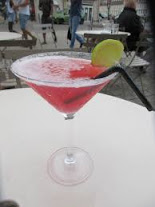The Cosmopolitan has a crazy history building up to the drink we know today.
The Cape Codder could be called a jumping off point for the Cosmopolitan. The Cape Codder was just a highball with vodka and cranberry with a lime wedge. It was made in 1945 as a promotion for Ocean Spray cranberry juice. The elements are clearly there for a Cosmo to come about, but the style still had a way to go.
The Harpoon seems to be the successor of the Cape Codder and a precursor to the Cosmopolitan. Some served it as a highball but for many it was 1 1/2 oz. Russian Vodka, 2 oz. Cranberry Juice, 1/4 oz. Lime Juice, and was shaken and served in a cocktail glass. The Harpoon was one of the first serious American vodka cocktails. Vodka really didn't start coming over to the States until the forties, after The Second World War. The Harpoon was first made in the 60's. You can see by the recipe, it's 3 out of 4 of the ingredients of a staple Cosmo. It's certainly a lot tarter and less sweet. But the style is there. The drink is shaken with the fresh lime juice so it has that presentation. the slightly opaque pink hue in a sexy glass. And that's really what the Cosmopolitan really is, it's an icon.
The Kamikaze is another drink that's sort of three-quarters the way to the modern Cosmo. It's vodka, triple sec, and lime. Throw in a little cranberry and there you have it. The Kamikaze has been served all sorts of ways, up, on the rocks, and namely as a shot these days. Neal Murray is one of many to claim to have invented the Cosmopolitan. He reportedly added some cranberry to a Kamikaze and one of his customers remarked, "How Cosmopolitan." This was back in '75.
The exact origins of the cosmopolitan, as we know it, are a bit up to speculation. A drink named the cosmopolitan did exist in the 1930's, but it used gin, Cointreau, lemon juice, and raspberry syrup. The base Cosmo as we know it probably came around in the mid to late 70's. There are numerous claims as to who first made it up. Toby Cecchini might have made up the current recipe at the Odeon in '88. The cosmopolitan with flavored vodka came about when Absolut was testing out Citron in Miami and a bartender by the name of Cheryl Cook in the mid-80's. Another story of its origin comes from Miami, this one from 1989 again as a plug for Absolut. There are also numerous murmurs of it being created in the 70's by the gay community in Provincetown Massachusetts, coincidentally where I used to vacation every summer, and probably spread to San Francisco or vice versa. Reportedly, however, the Cosmo of the gay bars was a ghastly drink with well vodka and Rose's lime and grenadine. In its later iterations, it began using fresh juice and more premium ingredients.
I pay much respect to Dale Degroff, aka King Cocktail, for breathing new life into this classic cocktail, though he was certainly not its true inventor. He was the owner of Rainbow Room in New York atop Rockefeller Center. His recipe is 1 1/2 oz Citrus Vodka (Ketel One Citroen or Absolut Citron), 3/4 oz Cointreau, 1 oz cranberry juice, 1/4 oz fresh lime juice. I like the use of fresh lime juice rather than Rose's. This makes the drink a gorgeous opaque pink. If you think of a Cosmo as a sweet transparent red drink, you've not had a fresh one. The true flair he added was the garnish, a flamed orange peel. That sharp burst of fire drew quite a crowd. Even Madonna was photographed drinking it which spread the word of the drink around the world and probably led to it being featured on Sex and the City where is got a second burst of popularity.
Miranda Hobbes: [at a bar, drinking Cosmopolitans] "Why did we ever stop drinking these?"
Carrie Bradshaw: "Because everyone else started!"
Photo Credit: Wikimedia











